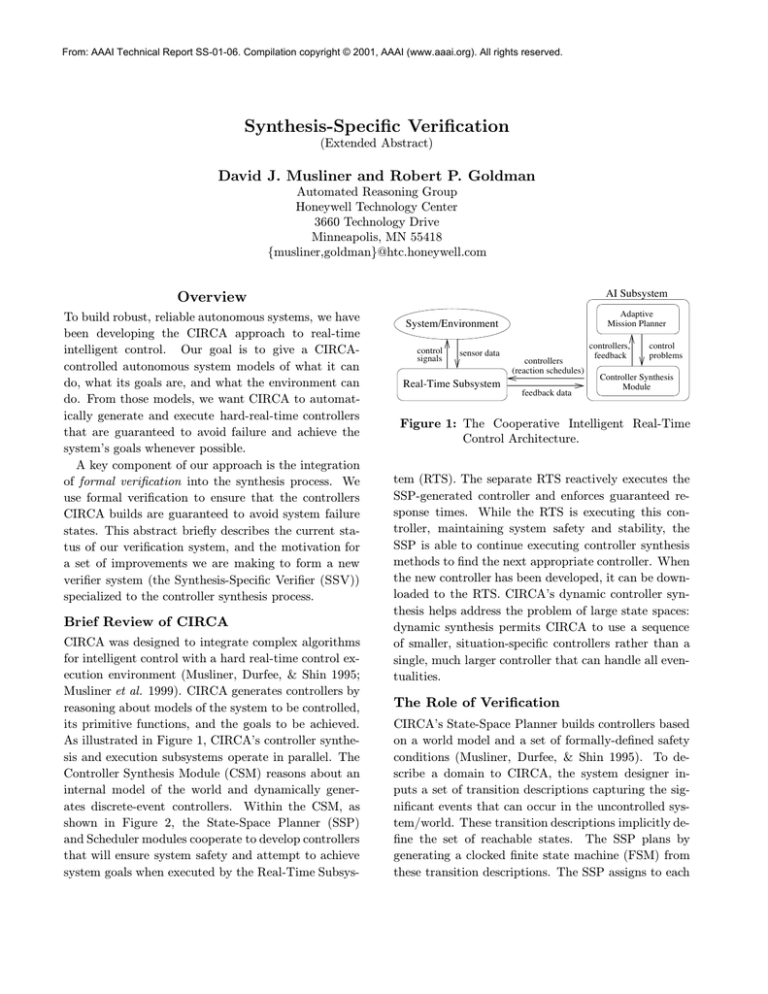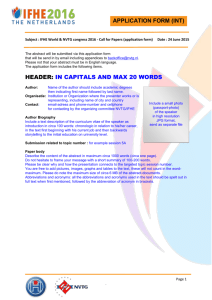
From: AAAI Technical Report SS-01-06. Compilation copyright © 2001, AAAI (www.aaai.org). All rights reserved.
Synthesis-Specific Verification
(Extended Abstract)
David J. Musliner and Robert P. Goldman
Automated Reasoning Group
Honeywell Technology Center
3660 Technology Drive
Minneapolis, MN 55418
{musliner,goldman}@htc.honeywell.com
AI Subsystem
Overview
To build robust, reliable autonomous systems, we have
been developing the CIRCA approach to real-time
intelligent control. Our goal is to give a CIRCAcontrolled autonomous system models of what it can
do, what its goals are, and what the environment can
do. From those models, we want CIRCA to automatically generate and execute hard-real-time controllers
that are guaranteed to avoid failure and achieve the
system’s goals whenever possible.
A key component of our approach is the integration
of formal verification into the synthesis process. We
use formal verification to ensure that the controllers
CIRCA builds are guaranteed to avoid system failure
states. This abstract briefly describes the current status of our verification system, and the motivation for
a set of improvements we are making to form a new
verifier system (the Synthesis-Specific Verifier (SSV))
specialized to the controller synthesis process.
Brief Review of CIRCA
CIRCA was designed to integrate complex algorithms
for intelligent control with a hard real-time control execution environment (Musliner, Durfee, & Shin 1995;
Musliner et al. 1999). CIRCA generates controllers by
reasoning about models of the system to be controlled,
its primitive functions, and the goals to be achieved.
As illustrated in Figure 1, CIRCA’s controller synthesis and execution subsystems operate in parallel. The
Controller Synthesis Module (CSM) reasons about an
internal model of the world and dynamically generates discrete-event controllers. Within the CSM, as
shown in Figure 2, the State-Space Planner (SSP)
and Scheduler modules cooperate to develop controllers
that will ensure system safety and attempt to achieve
system goals when executed by the Real-Time Subsys-
Adaptive
Mission Planner
System/Environment
control
signals
sensor data
Real-Time Subsystem
controllers
(reaction schedules)
feedback data
controllers,
feedback
control
problems
Controller Synthesis
Module
Figure 1: The Cooperative Intelligent Real-Time
Control Architecture.
tem (RTS). The separate RTS reactively executes the
SSP-generated controller and enforces guaranteed response times. While the RTS is executing this controller, maintaining system safety and stability, the
SSP is able to continue executing controller synthesis
methods to find the next appropriate controller. When
the new controller has been developed, it can be downloaded to the RTS. CIRCA’s dynamic controller synthesis helps address the problem of large state spaces:
dynamic synthesis permits CIRCA to use a sequence
of smaller, situation-specific controllers rather than a
single, much larger controller that can handle all eventualities.
The Role of Verification
CIRCA’s State-Space Planner builds controllers based
on a world model and a set of formally-defined safety
conditions (Musliner, Durfee, & Shin 1995). To describe a domain to CIRCA, the system designer inputs a set of transition descriptions capturing the significant events that can occur in the uncontrolled system/world. These transition descriptions implicitly define the set of reachable states. The SSP plans by
generating a clocked finite state machine (FSM) from
these transition descriptions. The SSP assigns to each
Figure 2: The CSM uses search and verification to
build controllers.
cancel-emergency
(action)
Emergency NIL
emergency-alert
(event)
Emergency T
emergency-failure
FAILURE
preempted
Figure 3: Preemption is the basis for automatic synthesis of guaranteed safe/stable real-time
discrete-event controllers.
reachable state either an action transition or no-op. It
selects actions to drive the system towards goal states
and to preempt transitions that lead to failure. Figure 3 shows a trivial preemption example in which the
SSP has recognized the reachability of a failure state
(potentially representing an undesirable instability or
a real catastrophic failure) and has selected a suitable
action that is guaranteed to definitely occur before the
transition to failure can possibly occur.
System safety is guaranteed by planning action transitions that preempt all transitions to failure, making
the failure state unreachable (i.e., constructing a stable set of states). In order to verify that the CIRCA
SSP’s plans are safe, we must project what will happen when they are executed. To do this, the SSP
uses a separate verifier module, employing techniques
developed in the computer-aided verification research
community to check the plans it generates. Specifically CIRCA uses techniques for verifying properties
of timed automata (Alur 1998). Initially, we used an
off-the-shelf, general-purpose timed automaton verifier,
Kronos (Yovine 1998). We have since moved to using
one of our own.
During synthesis, if the verifier detects that a failure state is reachable, it returns a path (an execution
trace) from an initial state of the system to the failure
state. The SSP uses the verification system’s output to
identify and repair the problem. The SSP maps entries
in the execution trace into entries in its search stack.
Each search stack entry corresponds to the assignment
of a control action to a reachable state.1 Thus for each
location that appears in an execution trace, there is a
corresponding decision in the SSP’s stack. This set of
decisions, taken together, make up a nogood: a set of
search decisions that, taken together, is inconsistent.
When encountering a verification failure, the SSP uses
a backjumping search method (Gaschnig 1979) to revise the most recent search decision that appears in the
corresponding nogood. For this application, backjumping is much more efficient than chronological backtracking. Indeed, for all but the simplest examples, chronological backtracking is simply infeasible, taking days of
compute time.
Note that the ability to automatically exploit the
execution trace is a substantial advantage of our approach. The execution traces provided by verification
systems are not minimal in any sense of the word. This
means that designers using a verification tool by hand
to evaluate a design must locate errors by extensive inspection of a program trace leading to failure. CIRCA
automates this process.
The use of the verifier in the synthesis process
means that CIRCA controllers are “correct by construction.” That is, if the model, the SSP and the
verifier are correct, the controller they generate will be
correct. In turn, the RTS will ensure that the correctlyconstructed controller will execute correctly.
Synthesis-Specific Verification
Our current integration of the controller synthesis and
verification processes is simple and uses existing verification techniques. Unfortunately, interfacing our
search-based synthesis methods to off-the-shelf verification systems is not an ideal solution, for several reasons:
Inefficient representations — While synthesis systems such as CIRCA reason about factored representations of state spaces, verification systems such
as Kronos and HyTech (Henzinger, Ho, & Wong-Toi
1
This is a slight oversimplification, but sufficient to
grasp the essentials.
Figure 4: Using a synthesis-specific verifier will
avoid model translation costs.
1997) do not. CIRCA does not generate the entire
state space of a system it is trying to control; instead,
it uses a factored “generator” representation of transitions to lazily create its representation of each state
only when that state is found to be reachable. As
a result, the huge number of system states that are
either innately unreachable or unreachable because
of designed controller actions are never generated,
explored, or reasoned about in any way. Standard
verification systems have no similar ability to lazily
generate representations of system states. Instead,
they must suffer the enormous exponential cost, in
both computation time and space, of representing
every possible state. Leveraging our experience with
the factored representation approach, we will build
this more efficient behavior into the SSV.
Data replication —
Translating state machine models from the synthesis
representation into the input language required by
a verifier (e.g., timed automata for Kronos) is both
time-consuming and wasteful, as it extensively duplicates the synthesis model to form the verifier model,
which is promptly discarded after verification. The
costs are incurred on the state representations (as
above) and also on the representation of transitions.
Each CIRCA-style model of a transition is actually a
description of many possible instantiated edges in a
standard verifier model. Since the verifier is used repeatedly to verify partial controllers during the synthesis process, this overhead is very significant. By
driving the new Synthesis-Specific Verifier module
directly off the synthesis models, our new CIRCA
system will avoid this inefficiency.
Inability to exploit discrete structure —
Existing verifiers for hybrid systems are very good at
exploiting structure in the continuous domains they
model. For example, timed automata verifiers such
as Kronos are designed to reason efficiently about
temporal information; they provide very powerful
automated techniques to recognize useful abstractions in time values (e.g., “clock-zones” and “regions”), but they are not so cunning with discrete
information such as state features. If a verification
system could have more in-depth knowledge of the
behavioral structure of a state space (i.e., how the
states can be connected by transitions), it could use
that information to computational advantage. The
SSV will have access to precisely that information,
through the factored representation of the synthesis
engine.
To avoid these pitfalls and provide highly efficient,
scalable hybrid systems verification services tailored to
the needs of CIRCA’s controller synthesis algorithms,
we are designing a new SSV with features including:
Close integration with CIRCA — By
sharing modeling languages with the CIRCA synthesis engine, the SSV will avoid translation costs
and storage penalties.
Factored state space handling —
Working directly off the CIRCA system model, the
SSV will take advantage of the built-in facilities to
reason about connectivity without pre-enumerating
all states.
Efficient dual abstractions — The SSV will exploit the same types of temporal abstractions used by
other verifiers, with the added benefit of also exploiting discrete-space abstractions provided by Dynamic
Abstraction Planning (Goldman et al. 1997).
Optimized verification functions — Because the
SSV is not intended to be a completely general purpose verifier, we can restrict the scope of its functionality and optimize the verification queries it does
support. Specializing to supporting controller synthesis may, for example, avoid the need to maintain
certain types of bookkeeping information.
SSV Status
We have completed a preliminary implementation of
the SSV concept that addresses some of the concerns
described above. In particular, the current version is
able to lazily generate discrete states, and it works directly off the synthesis model. However, the SSV has
not yet been integrated and tested with the Dynamic
Abstraction Planning version of the SSP, which we expect to result in very large performance improvements.
Despite these limitations, preliminary experiments
show that the performance of the unoptimized SSV is
1.00
|
0.10
|
0.01
|
Henzinger, T. A.; Ho, P.-H.; and Wong-Toi, H. 1997.
HyTech: A model checker for hybrid systems. Software Tools for Technology Transfer 1:110–122.
Musliner, D. J.; Goldman, R. P.; Pelican, M. J.; and
Krebsbach, K. D. 1999. SA-CIRCA: Self-adaptive
software for hard real time environments. IEEE Intelligent Systems 14(4):23–29.
|
Verification time (seconds, log scale)
|
10.00
Old verifier
New SSV
Verifier call index
Figure 5: Scatter plot of verification times for the
old verifier and the new SSV.
a dramatic improvement over the prior version. Running the old and new verifiers on a variety of different
domains, the cumulative verification time was 31.4 seconds for the old verifier and just 13.2 seconds for the
SSV, a 58% improvement. Figure 5 shows a scatter
plot contrasting the verification time for 14 different
calls to the verifiers, showing the consistent improvement in performance. We expect further improvements
as we take advantage of more of the synthesis-specific
characteristics noted above.
Acknowledgments
This material is based upon work supported by
DARPA/ITO and the Air Force Research Laboratory
under Contract No. F30602-00-C-0017.
References
Alur, R. 1998. Timed automata. In NATO-ASI Summer School on Verification of Digital and Hybrid Systems.
Gaschnig, J. 1979. Performance measurement and
analysis of certain search algorithms. Technical Report CMU-CS-79-124, Carnegie-Mellon University.
Goldman, R. P.; Musliner, D. J.; Krebsbach, K. D.;
and Boddy, M. S. 1997. Dynamic abstraction planning. In Proceedings of the Fourteenth National Conference on Artificial Intelligence, 680–686. Menlo
Park, CA: American Association for Artificial Intelligence.
Musliner, D. J.; Durfee, E. H.; and Shin, K. G. 1995.
World modeling for the dynamic construction of realtime control plans. Artificial Intelligence 74(1):83–
127.
Yovine, S. 1998. Model-checking timed automata. In
Rozenberg, G., and Vaandrager, F., eds., Embedded
Systems. Springer Verlag.





